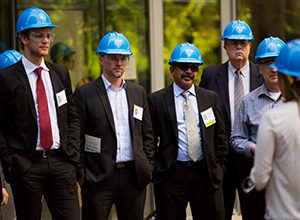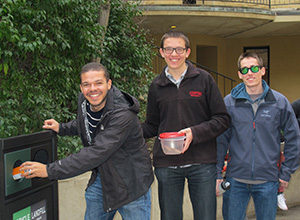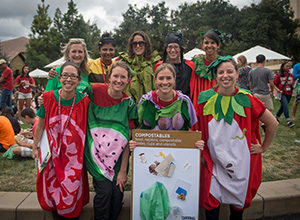Formed in 2008, Stanford’s Office of Sustainability (OOS) serves as the hub of Stanford’s sustainability programs, dubbed Sustainable Stanford. Action-oriented programmatic initiatives led by OOS help make sustainability both more tangible and more visible at Stanford.
Rooted in operations, OOS connects various organizations and entities and works collaboratively with them to steer key sustainability initiatives on campus. OOS focuses on the following six key areas of programs and services, supported by plans and metrics: infrastructural planning support; assessments, evaluations, and reporting; conservation campaigns; business systems; communications, training, and education; and collaborative governance.
As the programs and services have helped establish sustainability as a core value campus wide, OOS now operates as a business office in service of sustainability programs for the university and its partner departments.
Results
1. INFRASTRUCTURAL PLANNING SUPPORT
As the programmatic arm of operational sustainability efforts at Stanford, OOS works with the Department of Sustainability and Energy Management (SEM) and various other units across campus operations and academic groups to help develop long-term plans to improve campus operations and infrastructure.

OOS staff gives tour of Central Energy Facility
OOS played an instrumental role in the initial planning and ongoing outreach of the Stanford Energy System Innovations project, and it continues to provide crucial analysis to evaluate future program enhancements, such as expanding the renewable energy supply component.
In 2015-16, OOS partnered with the Department of Athletics, Physical Education, and Recreation (DAPER) and Peninsula Sanitary Service, Inc./Stanford Recycling to study waste bin infrastructure within Athletics facilities and prioritize potential improvements as the university seeks to enhance its zero-waste efforts. Opportunities to add compost bins in various Athletics facilities were the most highly prioritized.
2. ASSESSMENTS, EVALUATIONS, AND REPORTING
The university diligently tracks key performance indicators related to campus resource use and trends. This evaluation work is critical to assessing Stanford’s success in advancing the sustainability of both its physical campus and its programmatic and academic offerings.
OOS conducts an annual greenhouse gas (GHG) emissions inventory as a primary indicator of sustainability performance. After remaining relatively flat for a number of years, emissions decreased by 28% in calendar year 2015 to 128,690 metric tons of CO2 and will continue to drop in coming years as a result of the SESI program.
OOS works closely with buildings and facilities staff to determine the best path toward building sustainability and how to engage the campus community in improving performance. An expanded Plug Load Equipment Inventory evaluated off-campus buildings, student residences, and all School of Medicine buildings to develop an even more complete picture of plug loads on campus. These efforts have led to the establishment of a number of programs aimed at managing plug loads, many of which are implemented through the longstanding Cardinal Green Office program
The Cardinal Green Labs program, a cross-departmental collaboration led by OOS, provides resources and incentives specifically tailored to laboratories to help them operate as sustainably as possible. In its first year more than 150 labs have participated in one or more of its programs, which collectively save the university approximately $120,000 in annual research and utility costs.
A revamped Sustainable IT initiative in 2015-16 focused on reducing server energy consumption by virtualizing servers and relocating them to more efficient data centers. In the past year, approximately 80 servers were virtualized or relocated, saving approximately $16,000 in annual energy costs.
OOS takes a data-driven approach to evaluating its progress and in 2015-16 created an in-house building sustainability rating system to evaluate each building’s sustainability performance in six categories (energy, water, waste, purchasing, transportation, and occupant engagement), which combine into an overall weighted average sustainability rating. The system recognizes high-performing buildings and identifies buildings that need improvement. It has already motivated increased sustainability action in several facilities across campus.
Third-party sustainability evaluations help to highlight annual progress. In 2016, Stanford renewed its Gold rating through the Association for the Advancement of Sustainability in Higher Education’s (AASHE’s) Sustainability Tracking, Assessment & Rating System evaluation, and the university is regularly recognized by ranking institutions, including the Princeton Review, Sierra magazine, and GreenestColleges.com.
3. CONSERVATION CAMPAIGNS
Individual actions and awareness conserve resources, lower utility bills, and contribute to a campus experience consistent with the university’s overall commitment to sustainability. To increase institutional awareness and achieve results, OOS runs campus-wide Cardinal Green conservation campaigns. Each campaign encourages action to conserve resources, and 2015-16 saw increased participation across nearly all campaigns.

Campus members pledge to reduce, reuse, and recycle during RecycleMania
Informed by the plug load inventory, Cardinal Green Buildings included a focus on space heaters, equipment timers, and ultra-low-temperature freezers. In the annual RecycleMania competition, an expanded focus on training helped the university to increase its top-10 standings in five of the eight categories. The Take the Shorter Shower Challenge campaign helped to encourage continued water conservation in the face of the ongoing California drought. OOS partnered with DAPER and Residential & Dining Enterprises (R&DE) to distribute messaging and shower timers. R&DE also partnered with OOS for the annual Give & Go sustainable move out campaign, which diverted more than 30 tons of materials from landfill to Goodwill.
Building on the success of the conservation campaigns, and in an effort to make sustainability a tangible experience for everyone at Stanford, OOS piloted a new engagement platform—My Cardinal Green—aimed at providing personalized recommendations of actions that students, staff, and faculty can take to reduce their environmental footprint on campus. Users can be rewarded for their efforts and accomplishments.
Through My Cardinal Green and ongoing building performance programs, OOS can continuously engage the campus in conservation throughout the year, with focused attention on the areas of greatest impact. To this end, the Cardinal Green Event program launched campus wide in fall 2015 with the goal of enhancing the sustainability of the thousands of events hosted at Stanford each year. Through in-person consultation and targeted resources, campus event planners are able to identify no-cost and low-cost improvements for events of all sizes.
OOS continues to incorporate findings from the latest research and best practices in promoting behavior change, and draws on assessments and evaluations to identify the greatest programmatic opportunities.
4. BUSINESS SYSTEMS
The SEM business systems initiative addresses utilities data integration, resource efficiency, and data analytics to effectively measure and manage Stanford’s resources. This initiative improves business processes, promotes data-driven decisions, and offers analytical tools to optimize efficiency in the campus infrastructure and operations.
Data capture and integration: OOS has assumed responsibility for operation, maintenance, and continued expansion of the Utility Metering, Billing, Reporting, and Sustainability (UMBRS) system, which integrates disparate building controls and metering systems, stores data in a common database, and interfaces with the billing system to produce trends and reports that help manage utilities and maximize resource efficiency.
Following the successful implementation of sustainability dashboards for 100 buildings on campus, and capitalizing on the more streamlined data facilitated through UMBRS, OOS will expand the number of buildings on campus that feature real-time data. The dashboards showcase individual building utility consumption and performance, along with other sustainability features.
Reporting and analytics: Building upon the data capture effort, OOS collaborated with Finance and Administration to enable utility operations and consumption reports for individual business units. The business systems group has also teamed up with Facilities Energy Management to create tools for campus utilities demand forecasting.
5. COMMUNICATIONS, TRAINING, AND EDUCATION
A campus culture of sustainability cannot be created without widespread awareness of Stanford’s sustainability plans, programs, and achievements. OOS works to promote existing sustainability programs and to enhance campus-wide sustainability actions through a variety of communication and education channels.
The Sustainable Stanford website serves as the main source of information on sustainability across campus, and includes extensive information on campus metrics, trends, and initiatives. Beyond this, the portal represents an intersection of information and action, where individuals can affirm their commitment to sustainability initiatives and become engaged Cardinal Green citizens. The portal also showcases real-time building performance data that can help users clearly understand how their actions affect operations and resource consumption. The monthly Cardinal Green eNewsletter provides an easily digestible update on all things sustainability happening on campus, and its number of subscribers has increased 57% over the last year. Each year, OOS publishes this annual Year in Review to highlight sustainability progress, milestones, and achievements across campus.

Zero Waste Lunch during New Student Orientation
As a testament to these efforts, an annual Earth Day celebration showcases the breadth and depth of sustainability opportunities at Stanford. More than 30 campus groups unite to engage the campus and highlight sustainability across all aspects of campus life, and in 2015-16 the event included a partnership with academic groups on campus to host a series of activities throughout the day. Through this and other Cardinal Green events, attendees can experience sustainability at Stanford from the moment they arrive on campus. For students, New Student Orientation offers a first glimpse into this thriving culture.
Enabling this culture of sustainability requires equipping the community with the tools and information necessary to empower individual change. OOS interacts with faculty, staff, and students to design and implement training and engagement opportunities so that hands-on experience in sustainability is integrated into daily life.
Each year, OOS works with sustainability partners across campus to provide internship opportunities for students. In 2015-16, more than 35 students worked on cross-departmental Sustainable Stanford internships. To facilitate further engagement and encourage increased collaboration among staff and students, OOS this year hosted a Student Sustainability Working Group, resulting in greater dialogue and multiple partnerships to tackle specific issues on campus.
The Sustainable Stanford training series educates staff on ways to integrate sustainability into their daily life through targeted classes in energy efficiency and waste minimization. In 2015-16, OOS partnered with groups across campus to provide training specific to individual buildings, more than doubling the number of training participants.
OOS also regularly engages in on- and off-campus community outreach programs and events. Staff participate in approximately 50 outreach opportunities every year, including conferences, presentations, tours, tabling, and other activities. All campus communications and publications on sustainability are heavily influenced by and consciously integrated with the work of OOS’s academic partners in the School of Earth, Energy & Environmental Sciences, the Stanford Woods Institute for the Environment, the Precourt Institute for Energy, the Haas Center for Public Service, and their affiliates.
6. COLLABORATIVE GOVERNANCE
A core value such as sustainability is best integrated through collaborative governance, especially in a large institution like Stanford. Through strategic partnerships among administrative departments, faculty, and students, sustainability is embedded as a value-add supporting Stanford’s mission of education, research, and outreach.
In 2011-12, a group of faculty, staff, and student leaders initiated Sustainability 3.0, a strategic blueprint for the future of sustainability at Stanford. The Sustainability 3.0 process mapped out a shared and actionable vision for that sustainability over the next five to 10 years. Major goals stemming from this effort include leading sustainability by example through on- and off-campus actions and maintaining a global influence through sustainability in research, education, and operations. With these goals in mind, a framework of collaborative governance actively supports the continuation and refinement of sustainability programs, and remains instrumental to progress today.
The Provost’s Committee on Sustainability (2012) guides implementation of Sustainability 3.0 by bringing key leaders on campus together to focus on sustainability as a core value at Stanford. The Sustainability Working Group (SWG) (2006) comprises representatives from all parts of the university and works to continuously improve Stanford’s leadership in demonstrating environmental sustainability in campus operations. The group lends expertise in the evolving field of sustainability to enhance program development and advance opportunities for hands-on sustainability-related learning and service in the campus community. Sustainability Working Teams (2008) convene when needed to develop program recommendations, assess progress, and help implement policy recommendations in major operational areas related to sustainability. Each team activates when a specific initiative is under way and may be dormant once a project is being or has been implemented.
OOS programs continue to benefit from the guidance of this framework, and its staff directly address content creation and information dissemination as warranted by each group. Collaborative governance by faculty, staff, and students serves as the engine for all programmatic areas.
Looking Ahead
Moving forward, OOS will seek to continually enhance its programs and services to achieve maximum savings for the university. Now that OOS has shared the building sustainability ratings with key stakeholders across campus, the ratings will be posted publicly on the Sustainable Stanford portal and serve as a driver to engage schools and departments in sustainability programs and accomplish action plans to improve their ratings.
Cardinal Green programs will follow the same targeted approach for expanded opportunities in Offices, Labs, and Events. The Cardinal Green Office Program will focus on increasing energy savings at individual work stations by piloting newly available technologies. The Cardinal Green Labs program will test new solutions to lab-specific waste and expand the rebate program to additional lab equipment types such as lasers. OOS has partnered with R&DE to expand the Cardinal Green Event program to its more than 7,000 events, as well as with DAPER to promote green event practices at the Stanford Stadium and tailgating areas.
The portal will continue to serve as the main conduit for sustainability action and engagement at Stanford, and OOS will expand its tools and resources to provide a comprehensive sustainability network. Following evaluation of the My Cardinal Green pilot, as the program rolls out to a wider campus audience it will deliver critical metrics to evaluate campus behavior and identify opportunities for new initiatives, while allowing sustainability champions to be recognized and rewarded for their efforts.
This data-driven approach to sustainability will remain a crucial component of the OOS portfolio, and continued enhancement and additional integration through business systems initiatives will offer greater analysis of operations so that the university can continue to be vigilant on resource efficiency. OOS continues to explore hardware and software deployments and system training for managers and staff to achieve this efficiency. As the analytical capacity of the OOS portfolio expands, in addition to conducting the annual GHG inventory, the team will also manage the Renewable Energy Certificates generated by the off-campus solar photovoltaic plant coming online in 2016.
